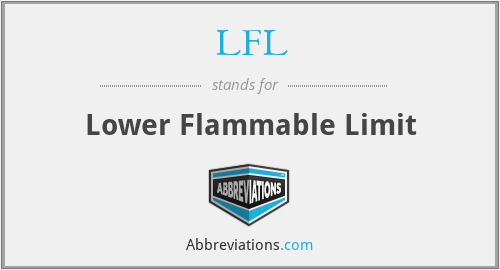What does LFL mean in Chemistry?
This page is about the meanings of the acronym/abbreviation/shorthand LFL in the Academic & Science field in general and in the Chemistry terminology in particular.
Submitted by paul8539 on September 15, 2006
Translation
Find a translation for Lower Flammable Limit in other languages:
Select another language:
- - Select -
- 简体中文 (Chinese - Simplified)
- 繁體中文 (Chinese - Traditional)
- Español (Spanish)
- Esperanto (Esperanto)
- 日本語 (Japanese)
- Português (Portuguese)
- Deutsch (German)
- العربية (Arabic)
- Français (French)
- Русский (Russian)
- ಕನ್ನಡ (Kannada)
- 한국어 (Korean)
- עברית (Hebrew)
- Gaeilge (Irish)
- Українська (Ukrainian)
- اردو (Urdu)
- Magyar (Hungarian)
- मानक हिन्दी (Hindi)
- Indonesia (Indonesian)
- Italiano (Italian)
- தமிழ் (Tamil)
- Türkçe (Turkish)
- తెలుగు (Telugu)
- ภาษาไทย (Thai)
- Tiếng Việt (Vietnamese)
- Čeština (Czech)
- Polski (Polish)
- Bahasa Indonesia (Indonesian)
- Românește (Romanian)
- Nederlands (Dutch)
- Ελληνικά (Greek)
- Latinum (Latin)
- Svenska (Swedish)
- Dansk (Danish)
- Suomi (Finnish)
- فارسی (Persian)
- ייִדיש (Yiddish)
- հայերեն (Armenian)
- Norsk (Norwegian)
- English (English)
Definition
What does LFL mean?
- Lower flammable limit
- Lower flammability limit (LFL), usually expressed in volume per cent, is the lower end of the concentration range over which a flammable mixture of gas or vapour in air can be ignited at a given temperature and pressure. The flammability range is delineated by the upper and lower flammability limits. Outside this range of air/vapor mixtures, the mixture can not be ignited (unless the temperature and pressure are increased). The LFL decreases with increasing temperature; thus, a mixture that is below its LFL at a given temperature may be ignitable if heated sufficiently. For liquids, the LFL is typically close to the saturated vapor concentration at the flash point, however, due to differences in the liquid properties, the relationship of LFL to flash point (which is also dependent on the test apparatus) is not fixed and some spread in the data usually exists. The L F L m i x {\displaystyle LFL_{mix}} of a mixture can be evaluated using the Le Chatelier mixing rule, if the L F L i {\displaystyle LFL_{i}} of the components i {\displaystyle i} are known: L F L m i x = 1 ∑ x i L F L i {\displaystyle LFL_{mix}={\frac {1}{\sum {\frac {x_{i}}{LFL_{i}}}}}} Where L F L m i x {\displaystyle LFL_{mix}} is the lower flammability of the mixture, L F L i {\displaystyle LFL_{i}} is the lower flammability of the i {\displaystyle i} -th component of the mixture, and x i {\displaystyle x_{i}} is the molar fraction of the i {\displaystyle i} -th component of the mixture.
Popularity rank by frequency of use
How popular is LFL among other acronyms?
LFL#1#8376#12977
Embed
Citation
Use the citation below to add this abbreviation to your bibliography:
Style:MLAChicagoAPA
"LFL." Abbreviations.com. STANDS4 LLC, 2024. Web. 27 Apr. 2024. <https://www.abbreviations.com/term/368083>.



Discuss this LFL abbreviation with the community:
Report Comment
We're doing our best to make sure our content is useful, accurate and safe.
If by any chance you spot an inappropriate comment while navigating through our website please use this form to let us know, and we'll take care of it shortly.
Attachment
You need to be logged in to favorite.
Log In